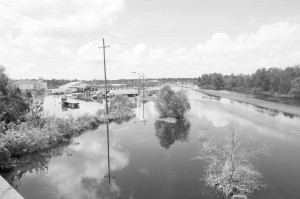Oil industry accidents, BP tarballs reported after Isaac
10th September 2012 · 0 Comments
By Susan Buchanan
Contributing Writer
At least 93 oil-and-gas industry accidents occurred in Louisiana during Hurricane Isaac, mainly because of poor preparation, suggesting companies had learned little from Katrina or the BP spill, Anne Rolfes, founding director of the Louisiana Bucket Brigade said last week. Reports from the interagency National Response Center, the federal point of contact for spills, showed accidents in every oil sector from exploration to transport and refining, she said.
Reported pollution from the state’s Isaac-related accidents totaled 4.9 million pounds and 171,000 gallons, but actual amounts were much greater, Rolfes said. Accidents included chemicals dumped by Exxon’s Chalmette Refining as it hurried to shut down just before the storm to a sunken Mississippi River barge containing petroleum coke dust. Chalmette Refining released 277 tons of sulfur dioxide on Aug. 27 and more chemicals on Aug. 31.

Flood waters are still causing problems for residents and businesses in LaPlace, La. after Hurricane Isaac passed through the area. FEMA is working with local, state and other federal agencies to provide assistance to residents and businesses affected by Hurricane Isaac.
On Thursday, the Bucket Brigade, the Gulf Restoration Network and the Sierra Club jointly released their accident findings from Isaac, and urged state and federal agencies to enforce environmental regulations rigorously.
Impacts of accidents were visible in recent flyovers by the Gulf Restoration Network, said Aaron Viles, GRN’s deputy director. Two coal terminals in Plaquemines Parish were flooded during Isaac, sending polluted runoff into surrounding waters, wetlands and farms. “Current plans to expand those two terminals should be halted,” he said.
Jill Mastrototaro, Sierra Club Gulf Coast campaign director, said “residents prepared for the storm, and industry should have been ramping up its efforts.” Oil and gas companies didn’t plan adequately based on reports of oil sheen, chemical releases and overturned tanks, she said.
Meanwhile, Isaac brought more oil from the 2010 BP spill ashore.
On Wednesday, Louisiana Dept. of Wildlife and Fisheries Secretary Robert Barham announced coastal waters around Grand Isle were closed to commercial fishing after a large tar mat and concentrations of tar balls appeared. State waters within one mile of beaches along Elmer’s Island at Caminada Pass to The Fourchon at Belle Pass were shut. Wildlife and Fisheries coordinated with the state’s Dept. of Environmental Quality, and the agencies said they were investigating the oil’s sources and environmental impacts.
Other areas remain shut to recreational and commercial fishing because of the 2010 BP spill, the agencies noted last week.
Based on tests that he conducted, Louisiana State University emeritus environmental science professor Ed Overton confirmed last week that oil found on Grand Isle and Elmer’s island after Isaac matched oil from BP’s 2010 spill.
BP spokesman Ray Melick said last week “some occurrences of residual oil from the Deepwater Horizon accident were expected in the wake of Hurricane Isaac. Thus far, the tar balls and tar mats that have been visually identified as likely consisting of residual oil from the Macondo well are in areas of the Gulf Coast in which spill response and cleanup activities are ongoing.” Those operations were suspended before Isaac but started to resume last week.
Melick said “Gulf Coast Incident Management Teams are taking samples to analyze the residual oil, in accordance with GCIMT sampling and fingerprinting protocols, to determine whether the material is associated with the Macondo well.” The Gulf Coast Incident Management Team for the Deepwater Horizon BP oil spill, formed in 2010, works with coastal states and federal agencies.
Aaron Viles said Gulf Restoration Network staffers saw fresh oil in Barataria Bay last week.
Meanwhile, a sinkhole in Assumption Parish has not grown since Isaac traversed the region, Texas Brine spokesman Sonny Cranch said last week. The salt water or slurry within the hole contains diesel fuel, and a nearby cavern is full of butane. More than 53 households have been evacuated from the area since early August.
“Any leaves and branches that fell into the hole during Isaac will simply add to decayed matter there,” Cranch said. When asked about fish kills in the vicinity, he said “the sinkhole contains no fish and the kills are unrelated to the hole.”
Louisiana DEQ spokesman Rodney Mallet said last week that “recent fish kills throughout the coastal region are probably related to Isaac. An influx of fresh water and vegetative debris caused changes in the oxygen content and environmental conditions of the water.”
At the sinkhole site, Texas Brine is drilling an observational well through a salt dome to a brine cavern, and might begin taking images of the cavern by month’s end to see if its walls were breached. The well won’t be used for production.
This article was originally published in the September 10, 2012 print edition of The Louisiana Weekly newspaper



